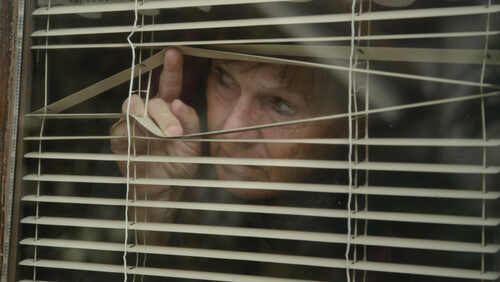This article on dementia and paranoia gives an overview of the signs, causes and emotional impact of paranoia symptoms in people living with dementia. Here are some practical ways to support them.

Page contents
Key Points
- Paranoia is a common and distressing symptom typically in moderate to late-stage dementia and is linked to changes in memory, perception, and trust.
- Understanding its causes such as memory loss, sensory misinterpretation, and environmental stressors is essential.
- Paranoia can significantly affect a person’s wellbeing and relationships, leading to refusal of care and increased risks.
- Strategies like validating emotions, creating calm environments and involving families can help manage symptoms effectively.
What is paranoia?
Paranoia is a complex and distressing symptom often seen in people living with dementia.
It manifests as persistent, irrational beliefs such as that others want to cause harm, are stealing belongings or are deceiving the individual.
In care homes, where residents may already feel disoriented or vulnerable, paranoia can greatly affect wellbeing, relationships and the delivery of care.
What stage is paranoia in dementia?
A question many people ask is ‘what stage is paranoia in dementia?’ Paranoia in dementia typically appears in the mid to late stages, though it can vary depending on the type of dementia and the individual.
It becomes more common as dementia progresses and brain damage affects perception and judgment, but it can occur earlier in some forms like Lewy body dementia.
Is paranoia a sign of dementia?
If you are wondering ‘is paranoia a sign of dementia?’, then yes, paranoia can be dementia symptom.
Paranoia in dementia often involves delusional thoughts, along with increased anxiety and mistrust.
It can appear in several ways, such as:
- Accusing others of theft or dishonesty.
- Believing that carers or family members are impostors or plotting against them.
- Refusing food due to fears of poisoning.
- Feeling watched, monitored or followed.
These symptoms are most prevalent in Alzheimer’s disease, Lewy body dementia and vascular dementia, particularly in moderate to advanced stages.
Understanding the causes and triggers
Paranoia is not a behavioural choice but a result of changes in the brain that affect memory, perception and thinking.
Several factors can contribute to this, including:
- Memory loss
Forgetting events or misplacing items may be seen as theft or deceit.
- Perceptual changes
Misinterpreting sights or sounds can increase suspicion.
- Emotional changes
Heightened anxiety or fear can make it harder to trust others.
- Environmental stressors
Unfamiliar settings, staff changes or noisy surroundings can trigger paranoid thoughts.
Recognising these causes helps care staff respond with empathy and understanding, rather than frustration or
confrontation.
What is the impact of people with dementia and those who care for them?
Paranoia can have a major impact on both the person experiencing it and those who care for them.
Someone with dementia and paranoia might experience:
- Emotional distress
Ongoing fear and suspicion can lead to agitation, social withdrawal or low mood.
- Relationship strain
Accusations may damage trust between care home residents, care staff and family members.
- Resistance to care
Paranoid thoughts can result in the refusal of medication, food or personal care.
- Increased risk
Avoiding care or isolating can raise the risk of malnutrition, falls and other safety concerns.
Practical ways on how to support someone with paranoia
1. Validate emotional experience
- Avoid directly challenging delusional beliefs.
- Instead, acknowledge the person’s feelings, for example: “I can see this is upsetting. Let’s look together and see what we can do.” This approach helps reduce distress and prevents escalation.
2. Optimise the environment
- Create a calm atmosphere by using personal belongings, familiar staff and reducing noise or overstimulation.
- A stable environment can reduce triggers for paranoia.
3. Identify and address triggers
- Observe behaviour and use life story work to uncover potential causes of paranoia such as pain, hunger or unmet emotional or social needs.
4. Offer reassurance and distraction
- Gentle reassurance, meaningful activities and sensory approaches such as music or aromatherapy can redirect focus and ease anxiety.
5. Involve family and friends
- Family members and friends provide valuable insight into the person’s history, routines and coping strategies.
- Their involvement supports the continuity and personalisation of care.
6. Document and monitor
- Keep clear records of paranoid episodes, possible triggers and effective responses.
- This promotes consistent care and supports informed clinical decision making.
7. Escalate when necessary
- If paranoia causes severe distress or poses a risk, escalate concerns to the person’s GP or mental health team. In some cases, a psychiatric assessment may also be needed to understand and manage a person’s symptoms.
- It’s also important to be alert to sudden confusion or behaviour changes which may signal delirium. Delirium is a medical emergency often caused by infection, dehydration or medication changes. If you think someone has delirium, they should be assessed promptly so the cause can be identified and treated early.
- Experiencing symptoms of paranoia can be distressing not only for the person living with dementia but also their family, carers and friends.
If you need advice or support on managing symptoms of paranoia, or on any aspect of living with dementia, contact Dementia UK’s Admiral Nurse Dementia Helpline on 0800 888 6678 or email helpline@dementiauk.org.